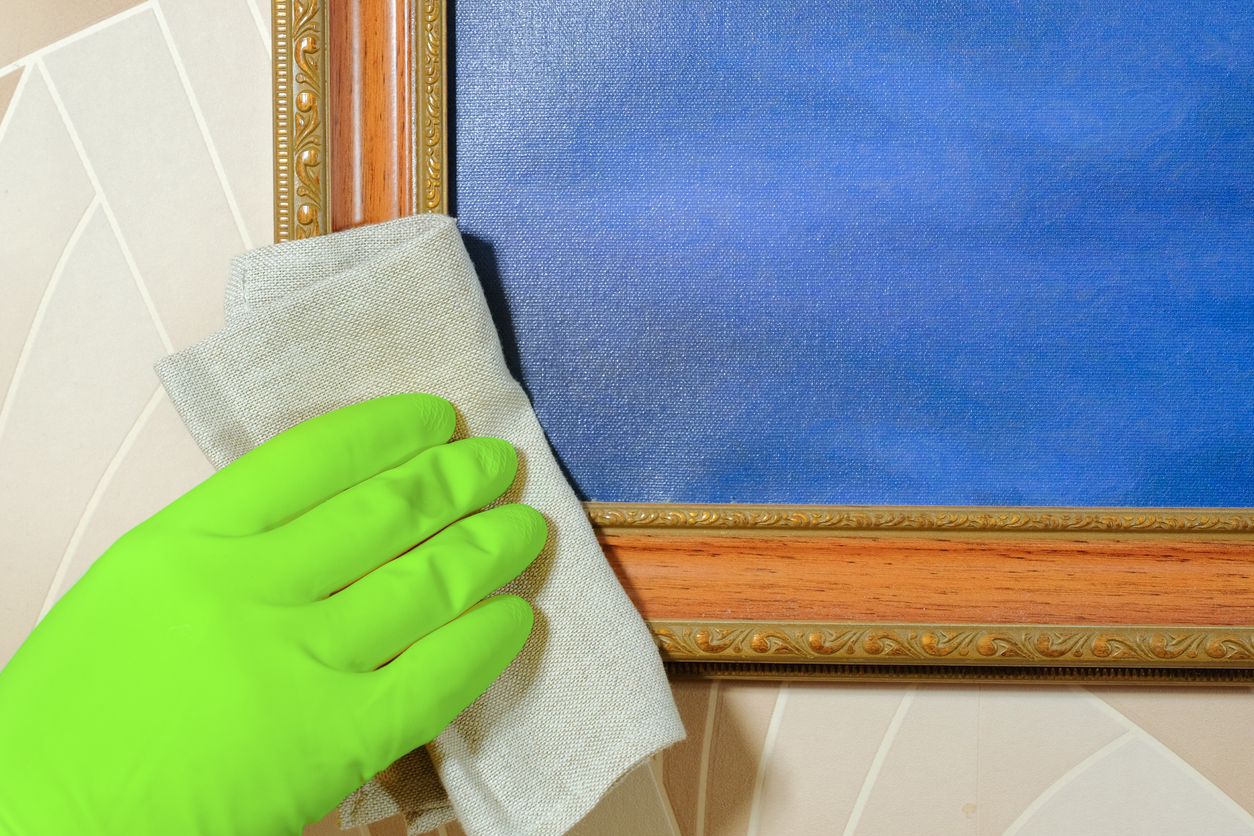

We may earn revenue from the products available on this page and participate in affiliate programs. Learn More ›
Art is a beautiful form of self-expression that brings joy and color to our lives. Whether it’s a piece of fine art or a store-bought canvas print, taking care of your artwork is crucial to ensure its longevity and appearance. Dust, dirt, and other pollutants can accumulate on the surface of your canvas painting, causing it to lose its vibrancy over time. Let’s look at how to clean canvas pictures safely and effectively so they look brand new.
Tools & Materials
Bobvila.com may earn a commission from purchases made through these links.
Project Overview
Working Time: 30 minutes
Total Time: 2 hours to 2 days
Skill Level: Beginner
Estimated Cost: $5 to $20

Before You Begin
While cleaning canvas paintings is safe, it’s important to approach the process with care and caution. Cleaning your canvas painting requires a delicate touch and the right materials to avoid damaging the painting’s surface or colors. Before cleaning the entire painting, do a spot test in a small, inconspicuous area to ensure your cleaning solution doesn’t damage the surface.
Typically, oil and acrylic paints are used to paint on canvas, and these types of paints can withstand the cleaning methods described below. If, however, you suspect your canvas painting was created with watercolor paint, you should seek expert advice before proceeding.
Similarly, if the painting is a valuable work of art or an antique, or for more extensive oil painting restoration, it’s best to consult a professional art restorer or conservator.
RELATED: The Best Paint Brushes, Tested and Reviewed
STEP 1: Dust the painting with a soft-bristled brush.
Use a soft-bristled brush to gently remove any dust or dirt that may have accumulated on the surface of the painting. Hold the painting upright and brush from top to bottom, starting at the upper-left corner and working your way down to the lower-right corner. Avoid applying too much pressure or scrubbing too hard, as this can damage the paint or cause it to flake off. Use a small paintbrush to clean the edges and corners of the painting where dust and dirt tend to accumulate. If the canvas is framed, carefully dust the frame as well.

STEP 2: Create a mild soap solution.
If the acrylic canvas painting is particularly dirty or stained, you can use a mild soap solution to clean it. Mix a few drops of mild dish soap into a bowl of lukewarm water. Be careful not to use too much soap, as it can leave a residue on the painting. Stir the solution gently to create suds. For more valuable or delicate paintings, use a pH-neutral cleaner or solvent specifically designed for cleaning oil paintings to ensure that your art isn’t inadvertently damaged.

STEP 3: Dip a clean cloth into the solution.
Dip a clean white cloth into the soap solution and wring it out to remove any excess water. The cloth should be damp but not soaking wet, as excess water can damage the paint. Be sure to use a clean cloth to avoid transferring dirt or grime. It’s best to use a microfiber or lint-free cloth because these are specially designed to avoid leaving any residue or fibers on surfaces, which can be particularly important when cleaning delicate canvas paintings.
STEP 4: Gently rub the surface of the painting with the cloth.
Gently rub the surface of the painting with the damp cloth using a circular motion. Be careful not to apply too much pressure or scrub too hard, as this can damage the painting’s surface. Work from the top of the painting to the bottom, and be sure to cover the entire surface of the painting. If the painting has any textured areas, use a cotton swab to clean those areas thoroughly, dipping the swab into the cleaning solution if necessary.
RELATED: 14 Craft Room Ideas to Inspire Scrapbookers, Knitters, and Other Creative Types
STEP 5: Allow the painting to air-dry completely.
After cleaning the painting, removing any excess water is important to prevent it from damaging the canvas or paint. Use a dry cloth or paper towel to blot the painting gently and remove any remaining water droplets. Once you’ve removed the excess water, it’s time to let the painting air- dry completely. Hang the painting in a cool, dry place where it can air out and dry completely. Avoid placing it near direct sunlight, as this can cause the paint to fade or crack. It’s also important to keep the painting away from any heat sources; heat can cause the paint to expand and contract, which can damage the canvas.

Final Thoughts
Cleaning a canvas painting is an essential part of maintaining its quality and appearance. With the step-by-step instructions and tips in this guide, anyone can safely and effectively clean their canvas paintings at home. You can preserve your artwork for years to come by using gentle cleaning methods and tools. If you’re unsure about how to clean an old oil painting that may be valuable, seek the advice of a professional art restorer or conservator.
